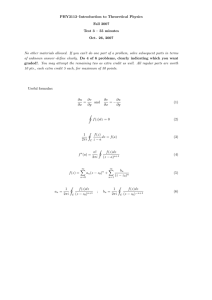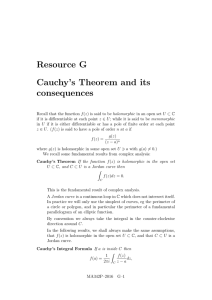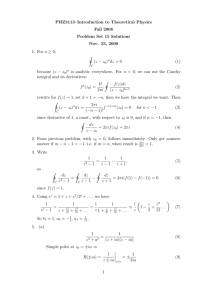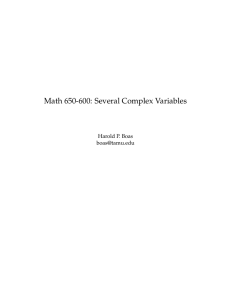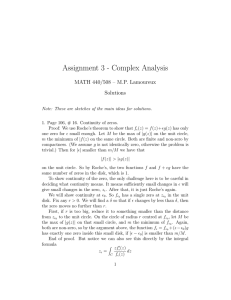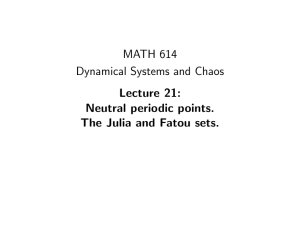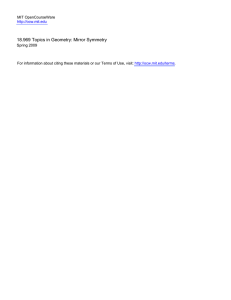May 4, 2009 Lecturer Dmitri Zaitsev Hilary Term 2009
advertisement
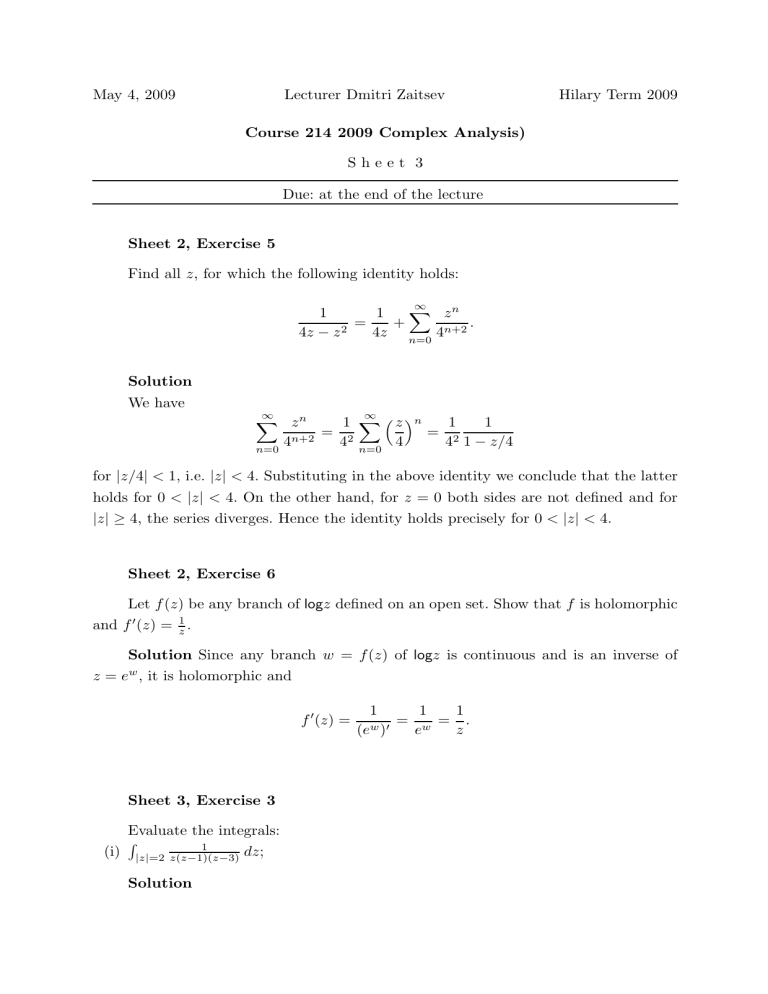
May 4, 2009
Lecturer Dmitri Zaitsev
Hilary Term 2009
Course 214 2009 Complex Analysis)
Sheet 3
Due: at the end of the lecture
Sheet 2, Exercise 5
Find all z, for which the following identity holds:
∞
X zn
1
1
=
+
.
4z − z 2
4z n=0 4n+2
Solution
We have
∞
∞
X
zn
1 X z n
1
1
= 2
= 2
n+2
4
4 n=0 4
4 1 − z/4
n=0
for |z/4| < 1, i.e. |z| < 4. Substituting in the above identity we conclude that the latter
holds for 0 < |z| < 4. On the other hand, for z = 0 both sides are not defined and for
|z| ≥ 4, the series diverges. Hence the identity holds precisely for 0 < |z| < 4.
Sheet 2, Exercise 6
Let f (z) be any branch of logz defined on an open set. Show that f is holomorphic
and f 0 (z) = z1 .
Solution Since any branch w = f (z) of logz is continuous and is an inverse of
z = ew , it is holomorphic and
f 0 (z) =
Sheet 3, Exercise 3
Evaluate the integrals:
R
1
(i) |z|=2 z(z−1)(z−3)
dz;
Solution
1
1
1
= w = .
w
0
(e )
e
z
The function
1
z(z−1)(z−3)
is holomorphic away from the singularities at 0, 1, 3, of
which 0 and 1 are inside the circle |z| = 2. By the Residue Theorem,
I=
Z
|z|=2
1
1
1
.
dz = 2πi Res0
+ Res1
z(z − 1)(z − 3)
z(z − 1)(z − 3)
z(z − 1)(z − 3)
We use the formula
(∗)
Resa
g(z)
= g(a).
z−a
Then
I = 2πi
(ii)
1
1
+
(0 − 1)(0 − 3) 1(1 − 3)
R 2π sinθ
dθ;
0 2+cosθ
Solution Using the substitution z = eiθ , cosθ =
=−
z+z −1
,
2
πi
.
3
sinθ =
z−z −1
,
2i
dθ =
dz
,
iz
we obtain
I=
Z
The function
2π
0
sinθ
dθ =
2 + cosθ
1−z 2
z(z 2 +4z+1)
Z
|z|=1
2
z−z −1
2i
−1
+ z+z2
dz
=
iz
Z
|z|=1
1 − z2
dz.
z(z 2 + 4z + 1)
is holomorphic away from the singularities at 0 and −2 ±
√
of which 0 and −2 + 3 are inside the circle |z| = 1. By the Residue Theorem,
I = 2πi Res0
1 − z2
1 − z2
√
+
Res
(−2+ 3)
z(z 2 + 4z + 1)
z(z 2 + 4z + 1)
.
We use the formula (*) and
(∗∗)
Resa
Then
I = 2πi
(iii)
R∞
x2
−∞ x4 −2x2 +2
Solution
dx;
g(z)
g(a)
= 0 .
h(z)
h (a)
!
√
1 − 02
1 − (−2 + 3)2
√
√
= 0.
+
02 + 4 · 0 + 1 (−2 + 3)(2(−2 + 3) + 4)
√
3,
Use the extension F (z) =
z2
z 4 −2z 2 +2
, which satisfies
lim zF (z) = 0
z→∞
and is holomorphic away from the singularities
π
±21/4 e±i 8 ,
π
π
of which 21/4 ei 8 and −21/4 e−i 8 are in the upper half-plane {Imz > 0}. Then using the
Residue Theorem, we obtain
I=
Z
∞
−∞
x2
π F (z)
π F (z) + Res
.
dx
=
2πi
Res
−i
i
(−21/4 e 8 )
(21/4 e 8 )
x4 − 2x2 + 2
Using (**) we have
Resa
z2
a2
a
=
=
4
2
3
2
z − 2z + 2
4a − 4a
4(a − 1)
and hence
I = 2πi
π
π
21/4 ei 8
−21/4 e−i 8
√ iπ
+ √ −i π
4( 2e 4 − 1) 4( 2e 4 − 1)
π
= 21/4 π cos .
8


